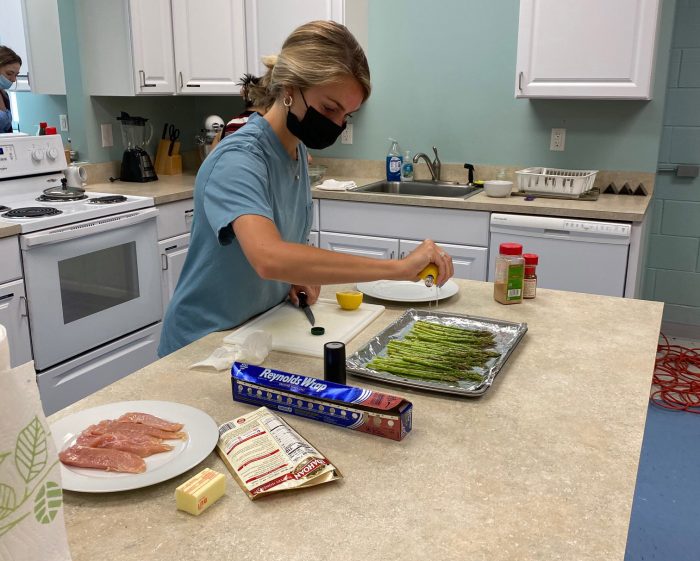
The students and teachers at Cape Hatteras Secondary School of Coastal Studies are in the final days of a most extraordinary school year. No doubt a stressful one, too, but they are finishing strong.
Family and Consumer Science Teacher, Evan Ferguson, had only six students in school out of the total of 14. The rest were virtual, and as Ms. Ferguson said, “Most did well online.”
The others were fortunate to have “hands-on time far above a normal school year,” Ferguson explained, and enjoyed the small class.
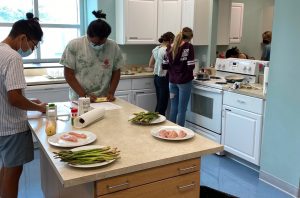
At first, they worked individually, because of the 6-foot distancing requirement, but when it came time to choose a kitchen partner, they were excited and motivated to do even better. As a result, they developed skills that Ferguson calls “impressive!”
Her students tell her that they want to take her class to “learn how to cook at home and to eat healthier.” Some get inspired to pursue culinary careers, but this is not a culinary course.
For most students, it is a practical life-skills course with a huge bonus – they get to eat their schoolwork!
This spring marked the end of their two-year course, and for the Food and Nutrition Honors Students attending school in person, it culminated with a little extra fun in the kitchen/classroom/lab: an opportunity for a challenge based on the popular Food Network TV show, “Chopped.”
Ferguson explained that the students watched the television show and liked the idea of participating in their own version. The rules were adjusted to their level, and they were given a few days’ notice to research recipes. It was, Ferguson said, “a good opportunity for them to get more comfortable reading through and using recipes.” One student even used one of her mother’s recipes.
In case you’ve never seen “Chopped,” competing chefs are given the same key ingredients, (like a specific meat or vegetable), that they then must use to create an inspired dish, which is judged by a panel of experts. In the show, the chefs who create the best dishes out of the identical ingredients move on to the next round, while the lowest-scoring chef gets effectively “chopped.”
In Ms. Ferguson’s class, the students were given polenta, (in a tube), fresh asparagus, and fresh chicken. Everything in their class pantry was available, and they could request two additional ingredients that Ferguson purchased for them at Conner’s. They had 90 minutes of cooking and plating time.
At first, the students were a little nervous, as none had ever seen polenta before, and they had to figure out how to incorporate it into the other ingredients. Most made a creamy version, and one fried it.
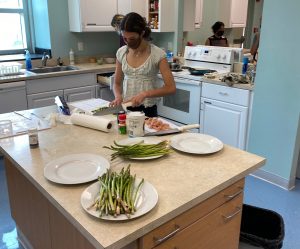
A few jitters were appropriate. It was a competition, after all, although a friendly one – And at least it wasn’t their final exam! But, with their partners, they quickly fell into a productive pattern.
“Because of the use of chicken, I had concerns about cross-contamination, so I was watching very carefully,” but, Ferguson boasted, “They all did a really great job with food safety!”
Others measures included something that many new cooks, (and some experienced ones), struggle with; getting all the ingredients on the plate while they were still warm, and they aced that, too! They also all created attractive dishes for the plating judgment part of the contest.
They were encouraged to taste as they cooked and adjust flavorings as needed. Their selection of flavorings was interesting. One of the winners went outside and cut fresh rosemary. Some used hot peppers, Italian seasoning, thyme, and Parmesan cheese, and most used fresh lemon and layered flavors that Ferguson felt were appropriate for the assigned ingredients.
I have already put in a request to be a guest judge next year!
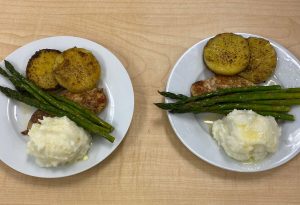
Chloe Flythe and Catherine Rebollo Guevara made seasoned baked chicken tenders, mashed potatoes, fried polenta rounds, and roasted asparagus. (The roasted asparagus was from Chloe’s mom’s recipe.) Here’s how they created their delicious polenta rounds:
TO FRY POLENTA ROUNDS
- Refrigerate polenta rolls before frying. Evenly slice the polenta roll. Heat olive oil or butter in a nonstick skillet and add the slices. Cook until the exterior is browned, and the interior is warm. Polenta rolls are already cooked, so it won’t require a lot of frying time.
- Toss asparagus in butter, salt, and pepper, and roast at 400F until done, when a knife point easily enters the spear. Sprinkle with lemon juice.
Malia Speedy and Madison Morrell prepared Chicken Ragu over Creamy Parmesan Polenta, and the recipe is below.
CREAMY PARMESAN POLENTA
- 1 cup milk
- 1/2 cup chicken broth
- 1/2 teaspoon salt
- 1 tube polenta
- 3 tablespoons butter
- 1/2 cup grated Parmesan
- Whisk polenta, milk, and salt on medium heat. Cook, stirring occasionally. Texture will be thick and fluffy, and should pull away from the sides of the pot.
- Remove from heat, and stir in the butter and cheese. Add more salt if needed.

CHICKEN RAGU
- 1 chicken tenderloin, chopped
- Salt
- Pepper
- Rosemary
- Thyme
- 2 teaspoons olive oil
- 1 cup chicken broth
- 6 small tomatoes, cut into 4ths (add or subtract if needed)
- 1/2 small onion, chopped
- Asparagus, chopped
- 2 big carrots, chopped
- Chop chicken into small pieces and season with salt, pepper, thyme, and rosemary, (just eyeball measurements).
- Add olive oil and chicken to a large skillet and cook on medium high until golden on all sides, about 7 minutes.
- Add chicken stock, tomatoes, asparagus, onion, and carrots and bring to a boil, about 5 minutes.
- Ladle over polenta and sprinkle with Parmesan and rosemary.
Alexis Zavala and Alan Garcia Velasquez cooked Chicken and Polenta with Asparagus. Their recipe is below.
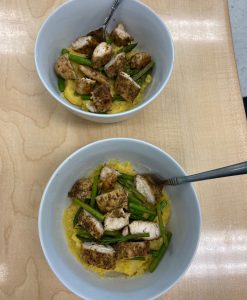
CHICKEN AND POLENTA WITH ASPARAGUS
CHICKEN:
- 2 large boneless chicken breasts sliced 1/2 through their thickness to male 4 thinner portions
- 1 tablespoon Italian seasoning
- 1/2 teaspoon salt
- 1/4 teaspoon pepper
- 1/2 teaspoon garlic powder
- 1 pinch red pepper flakes
- 1 tablespoon butter
- 1 tablespoon olive oil
- 1 roll polenta
- 3/4 cup chicken broth
- 1/2 teaspoon
- Mix Italian seasonings, salt, pepper, and garlic powder, and sprinkle evenly over both sides of the chicken.
- Heat a nonstick skillet over medium heat and add the butter and oil. When the butter has melted and the skillet is hot, add the chicken and sauté until golden brown, about 5-6 minutes per side. Transfer to a plate and cover with foil.
POLENTA
- Add the polenta to a medium saucepan, breaking it up with your fingers as you add it. It’s OK if there are lumps. They will cook out.
- Add the chicken broth, salt, and red pepper flakes, (if you are using them), and stir well.
- Spoon chicken over cooked polenta.
While not a culinary program, one of her former students, Delaney Johnson, recently graduated from Johnson and Wales University Culinary Arts program at the College of Food Innovation and Technology in Charlotte and another, Emilie Fulcher, is currently studying in that same program. That is impressive for such a small island school!
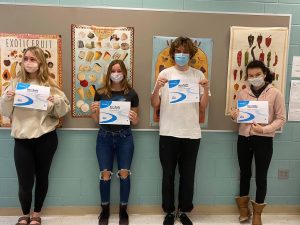
Evan Ferguson is also a Certified ServSafe Instructor and Proctor, and proudly awarded certificates to eight students.
Five are currently employed in the food service industry on the island:
- Hobson Frye, Subway
- James Tawes, Conner’s
- Sydney Brown, BoardWok and Hatteras Bowls
- Lucas Blankenship, Lisa’s Pizza and Village Conery
- Casia Ensenat, Gingerbread House
Also received their ServSafe but are currently working in other fields:
- Alexis Zavala-Roldan
- Lillian Ratliff
Considering all of the major challenges that have faced our island teachers, students, and staff, I‘d say they rose to the occasion and made the best of a far-from-ideal situation. And now, Hatteras Island has another group of young people well prepared to take on jobs in our food establishments and, equally important, to feed themselves and their future families very well!
Thank you, Evan Ferguson and everyone at Cape Hatteras Secondary School of Coastal Studies for your inspired and hard work!



